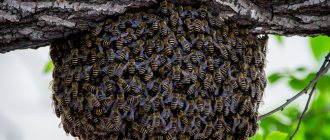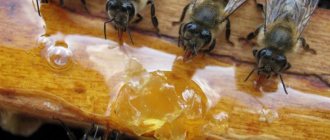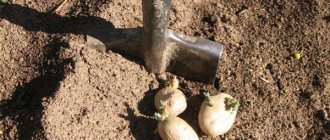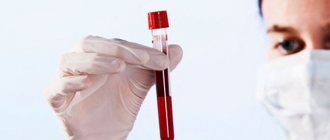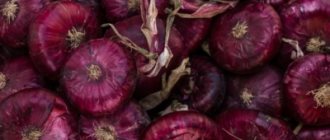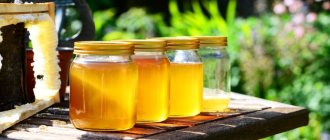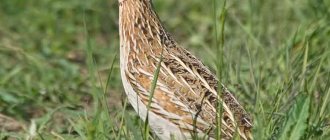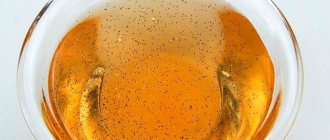Of all beekeeping products, wild honey is a very rare variety. The main territory of its production is Bashkiria, the Urals, and the Carpathians. Wild bees live there, making their nests in stumps and tree hollows.
Another name for this product is on-board honey.
Wild bee honey is a type of flower honey. This is what bears love in the forest. This product is in high demand because of its environmental friendliness; it is a completely natural product.
It is almost impossible for wild bees to include additives in their diet, as is sometimes done in an apiary. This ensures the purity of the product.
The Bashkir and mountain (Carpathian) species are of greatest value.
Honey from wild bees, wild honey - what is it, beneficial properties
This variety was named so because it appeared thanks to wild bees. This is a real natural product. A person only collects the finished substance and does not participate in its production in any way. This type is platinum and is very expensive. Such beekeeping flourishes only in a few places.
The beneficial properties were known to our Slavic ancestors. The composition contains a large number of vitamins, amino acids, proteins, and microelements. One spoon of this substance replaces the body with a daily dose of elements necessary for health. It is not only useful, but also medicinal.
How to use it correctly
Consuming this sweet treat daily will bring great benefits to the body. An adult can eat 1–2 tbsp. spoons of the product per day, and for a child - no more than two teaspoons.
Unfortunately, some people make a fairly common mistake - putting honey in hot tea. It is not right. When exposed to high temperatures, it loses many beneficial properties. You should also not immediately swallow the treat; you need to hold it on your tongue for a little while, tasting it with all your taste buds.
The product does not react well to metal, so it is better to find a wooden or plastic spoon. In addition, do not leave nectar in a saucer or vase on the table, as it will begin to change its properties when exposed to air. Take from the jar exactly as much honey as you intend to eat at one time.
Characteristics of wild bee honey, Wikipedia
Beekeeping is a Slavic and ancient type of beekeeping. To get honey, wild bees create bees in trees. Bees breed there and produce an incredibly useful substance. It is collected by real beekeepers. Wild bees are listed in the Red Book, so honey is very expensive.
Color
The shade is dark brown, amber. Extraordinarily beautiful and unlike other varieties.
Taste
The taste is rich, slightly tart. It may not be the same, but there is no significant difference. Does not resemble other types of similar products.
The smell of wild bee honey
The aroma is very pleasant, tasty, you can feel a hint of wax.
Crystallization
Wild Bashkir honey contains a large amount of glucose. The crystallization process occurs when it begins to settle in the mass of the product.
Candied or not?
Each variety of this product can be candied. Once it has been harvested, it can crystallize faster because it contains more fructose. Candied if stored properly for about a year. This is due to its very thick consistency.
Compound
The composition of this product is very rich. It contains the following useful substances: glucose, fructose, enzymes, proteins, amino acids, hormones, vitamins A, B, C.
Calorie content
Calorie content can be determined by the following standards: 1 teaspoon – 39 kcal, tablespoon – 115 kcal, 100 g – 300 kcal.
What was the name for collecting honey from wild bees among the Slavs? It is important to know
The Slavs called this species bortev. The name comes from the type of beekeeping. Our ancestors were the first to engage in beekeeping in Rus' and preserved this knowledge for the future generation.
Treatment of diseases
This variety is known for its medicinal properties. Effectively helps with diseases of the digestive system, respiratory and viral diseases, dysfunction of the heart, kidneys, thyroid gland, and blood vessels. Due to its antibacterial effect, it is used for skin diseases.
How to counterfeit
Counterfeiting of honey products is rampant these days. Thickeners, sugar and food additives are added to the substances. In this case, beneficial properties and taste factors are lost.
There can never be too much of a good thing
Considering all that has been said, it is easy to conclude that real wild honey is quite rare, it is the “sweet elite”. Accordingly, it should cost several times more than usual. Therefore, such a product is counterfeited even more readily than a traditional one.
Most often, honey from ordinary hives is passed off as on-board honey, but not pumped out in a honey extractor, but squeezed out of honeycombs. Of course, such a product is also very useful, but it is still inferior to the airborne product. In this regard, it is worth mentioning that when extracting real wild honey, it is pressed exclusively with a wooden vice and stored only in special containers to avoid contact with metal.
Another type of “cheating” option is a product from decks. Indeed, log beekeeping is gaining popularity, and this honey is quite similar to that created by wild insects. The difference is that the logs are in apiaries. Accordingly, bees collect honey in them in ordinary fields, and not in secluded forest areas remote from civilization.
Honey from wild bees: beneficial properties and contraindications. What are the benefits of honey? Indications
This substance can be used in the treatment and prevention of almost all diseases. The only contraindication for use is the presence of an allergy or individual intolerance to the components in the product. Honey from wild bees has beneficial properties that will help you quickly cure many diseases.
Colds
This substance has a wonderful healing effect. Thanks to its anti-inflammatory and antibacterial effects, it helps to get rid of colds faster. Use instead of sugar in tea until complete recovery.
Gastrointestinal diseases
The use of honey products will help with gastritis, stomach ulcers, tendency to constipation, and indigestion. The medicinal substance helps normalize intestinal functions and stimulates peristalsis. The risk of constipation is reduced, and bowel movements are facilitated in the presence of hemorrhoids.
Diseases of the cardiovascular system
This product helps normalize blood circulation and strengthens blood vessels. In addition, it strengthens the heart and reduces the risk of developing heart diseases. It is recommended to take 1 tbsp 2 times a day. spoon.
Diseases of ENT organs, bronchial asthma
With such diseases, honey helps with sore throat, stomatitis, pharyngitis, and irritation of the nasopharyngeal mucosa. It cures cough faster and has a good effect on the bronchi and trachea. If you have bronchial asthma, use with extreme caution, only on the recommendation of a doctor.
Skin diseases
The use of this product helps to effectively cleanse the body of toxins. Accordingly, this helps cleanse the skin. For external use, compresses or lotions are used.
Restoring the nervous system after stress
The healing product has the ability to improve mood and restore cheerfulness. After suffering stress, it is an indispensable remedy. You can add it to soothing, herbal teas. It is recommended to drink before bedtime. Instead of tea, you can use warm milk.
Disease Prevention
The characteristics of this product allow it to be used for the prevention of respiratory, viral and other diseases. Adults should take 1 tbsp on an empty stomach. spoon, for children - 1 teaspoon.
Rules for use and storage
How to check whether honey is natural or not at home using iodine
Some people are allergic to bee products.
Are there any contraindications to this variety:
- Wild honey is not given to children under two years of age.
- And also for persons with individual intolerance. As an allergen, it can cause asthma-like asthma attacks or anaphylactic shock.
- Pregnant women and diabetic patients should use it with caution.
It is recommended to store honey at temperatures from +5 to +7 degrees C. Its beneficial properties may be lost at 40 degrees Celsius or below 30 degrees below zero. The wild variety of this product is not heated and is protected from sunlight and light. Choose glassware. Metal or plastic are less suitable. Air humidity should be 60% or higher. Absorption of excess moisture does not threaten the product.
Storing wild honey
Wild natural honey is a type of flower honey. This is what bears love in the forest. This product is in high demand because of its environmental friendliness; it is a completely natural product. It is almost impossible for wild bees to include additives in their diet, as is sometimes done in an apiary. This ensures the purity of the product. The Bashkir and mountain (Carpathian) species are of greatest value. The full range of beneficial properties can only be felt by tasting wild honey.
0 0 votes
Article rating
Beauty Recipes
This product is expensive. In cosmetology, this is an indispensable component that is added to almost all products. Independent procedures will be no less useful than expensive cosmetics.
Face masks
These masks are recommended to be used once a week. Honey is quite thick, so various essential oils are added to it. For example, apricot or grape seeds. Apply to cleansed facial skin for 15 minutes and then rinse with warm water.
Hair masks
Hair masks will be healthier than ready-made, store-bought products. Honey can be mixed with natural henna. Apply to dry hair for about 40 minutes. Wrap them in a warm towel. After this, you just need to wash your hair with shampoo.
Wild bee honey for body
Honey baths with milk are considered beneficial for the body. But not everyone can afford this pleasure. Therefore, it is recommended to use this substance as a body toner. You can add a small amount to a regular bath. The skin becomes more elastic and firm.
Massage
This substance has a calming and relaxing effect. Excellent for therapeutic massage. You can also replace your regular massage oil with this product to get better results.
Compound
The wealth of useful substances distinguishes wild honey from other varieties; it includes:
- fluorine;
- manganese;
- iron;
- calcium;
- iodine;
- zinc;
- copper.
There are also many vitamins - group B, as well as E, C, K and others. Bee products contained in wild honey include:
- pollen;
- I;
- bar;
- wax;
- drone brood;
- bee bread;
- bee jelly.
In addition, the product contains enzymes, sucrose, and glucose.
Why so expensive?
First of all, the high price of airborne honey is explained by the complexity and limitations of its production. Since honey has to be collected from the borti manually, at a height, under the attack of an aggressive swarm of bees, the process is accompanied by serious precautions and requires considerable effort. At the same time, wild honey is collected only once a year for 2–3 weeks, and one swarm of bees brings no more than 10–15 kilograms of product per season. In addition, on-board honey is pure and natural and does not contain artificial additives, which beekeepers often use.
Collection technology
Since the wild counterparts of apiary bees sting much more aggressively, collecting on-board honey becomes a difficult task. It has been established that the sting of one hundred bees can cause death.
For this reason, all areas of the body should be covered as much as possible with thick fabric, and the head should be protected with a special headdress with a mesh. During the honey collection, the bees are smoked out - driven away with smoke. To collect honey, wooden tubs are used, where the extracted honeycombs are placed. The harvest is carried out in late summer, and this guarantees the complete ripening of the delicacy.
The honeycombs are also removed with wooden spatulas, which preserve the beneficial properties of honey, very carefully and smoothly. Part of the honeycomb must be left on the sides.
